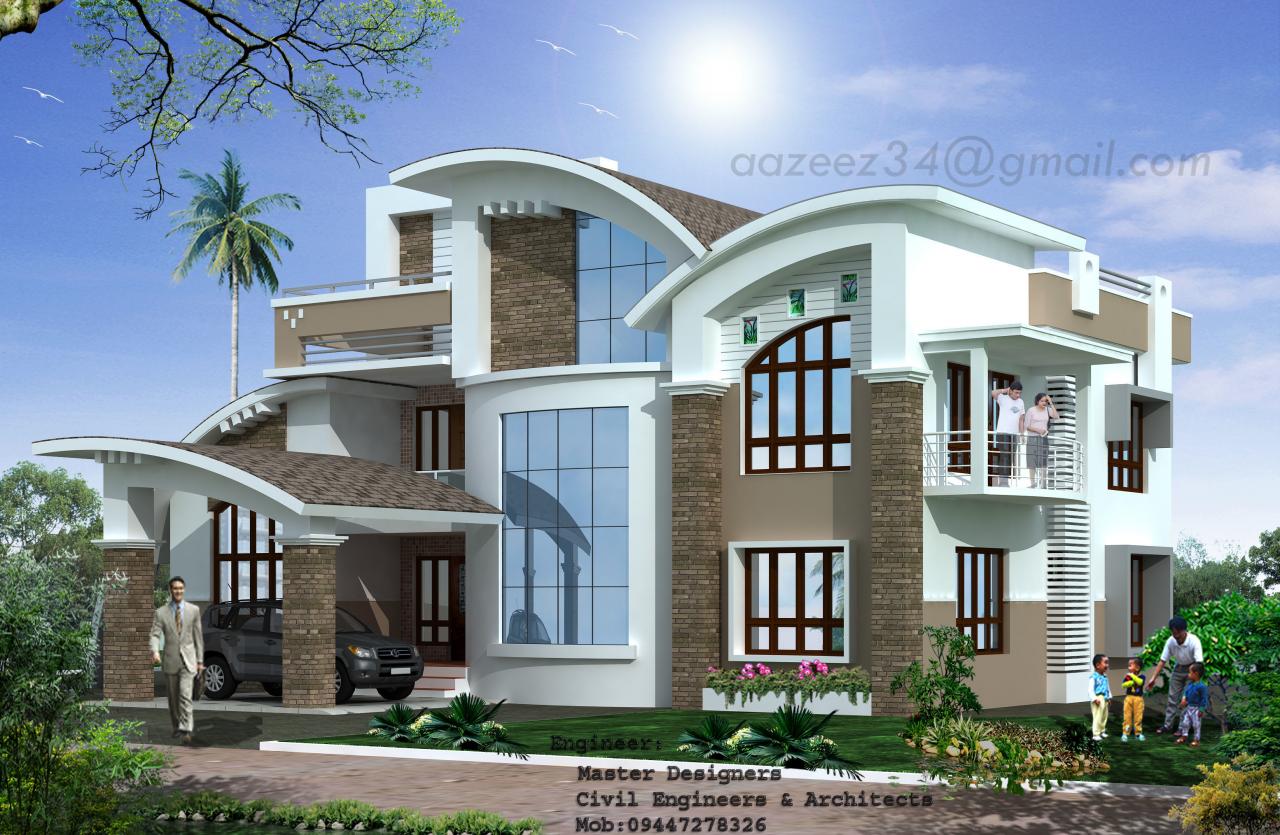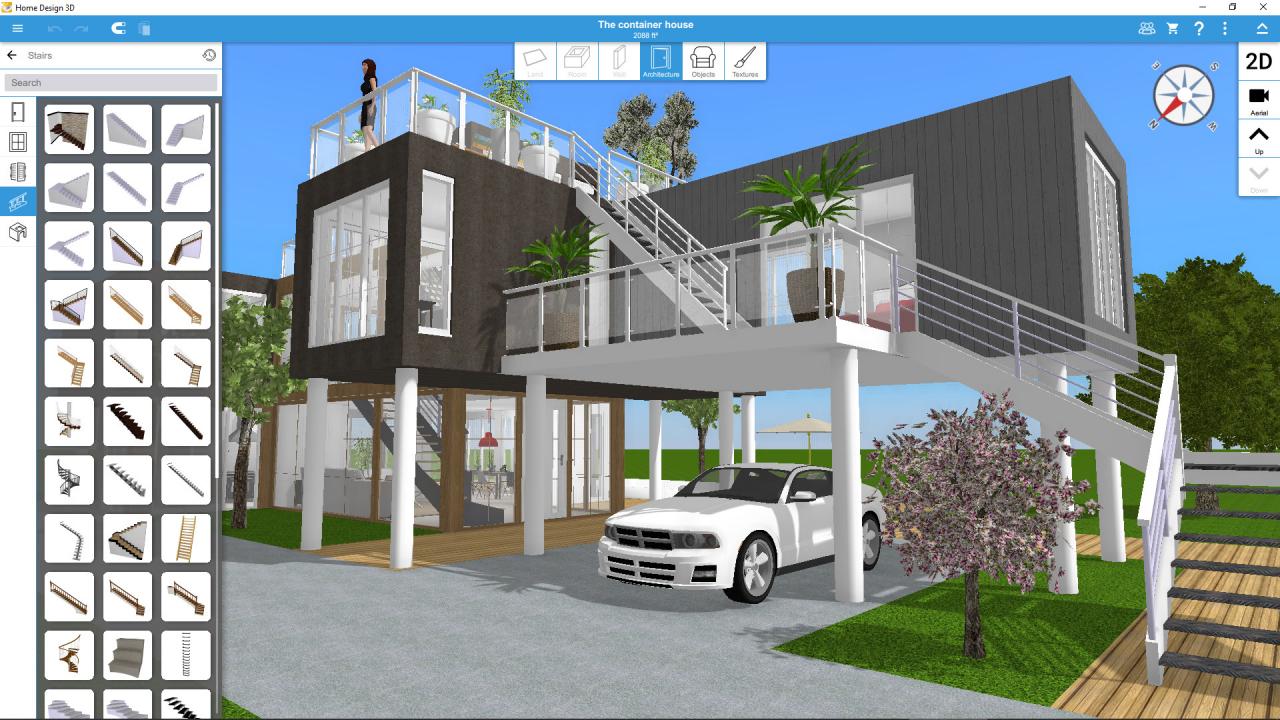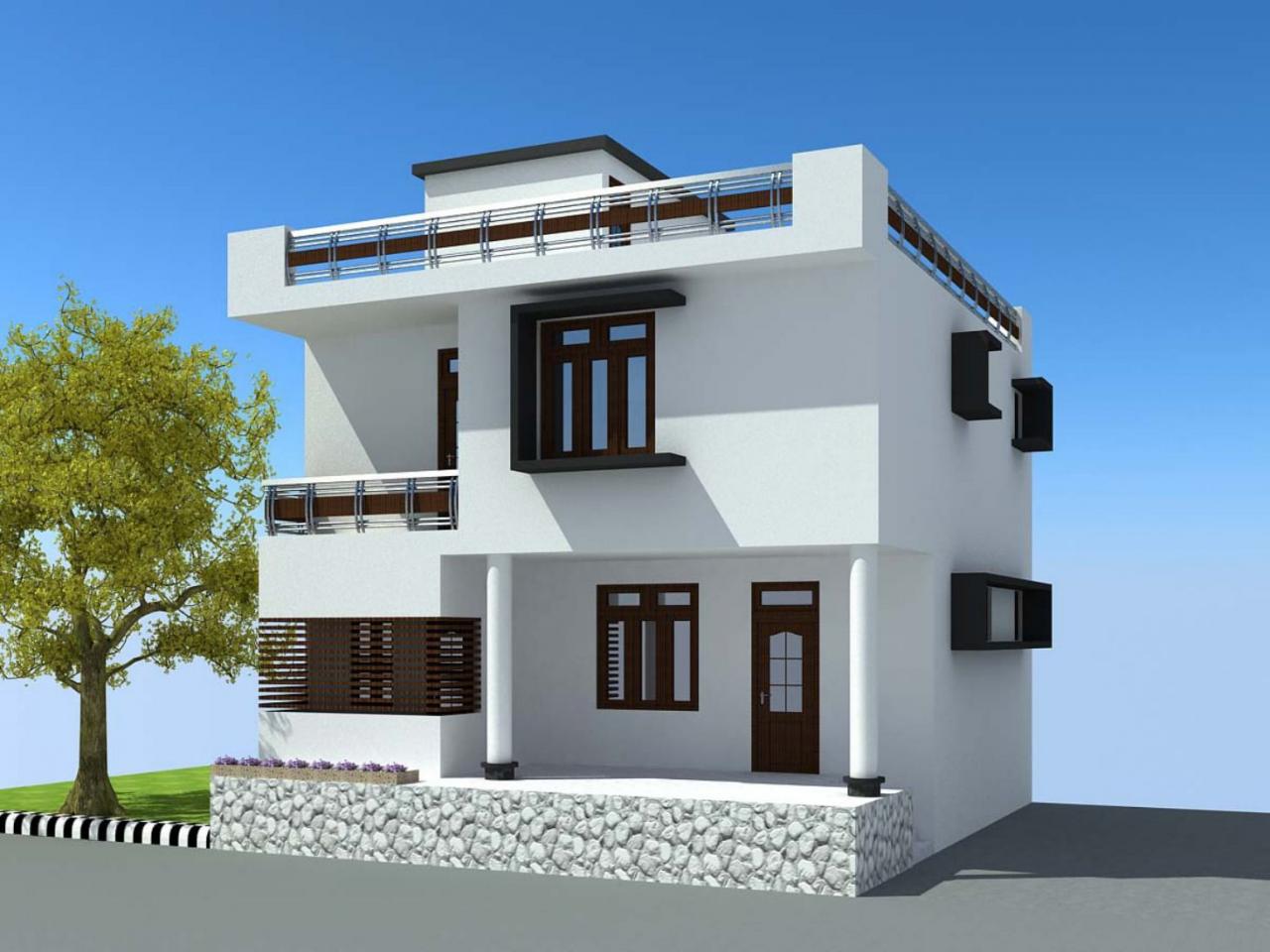Home Design 3D software is revolutionizing how we plan and visualize our dream homes. From initial sketches to photorealistic renderings, these powerful tools empower homeowners and designers alike to explore countless possibilities before a single brick is laid. This guide dives deep into the world of 3D home design, exploring software options, layout strategies, material choices, rendering techniques, and even the exciting potential of VR and AR.
We’ll cover everything from choosing the right software based on your skill level and budget to mastering advanced techniques like texture mapping and parametric modeling. Whether you’re a seasoned architect or a first-time homebuyer, get ready to transform your vision into a stunning 3D reality. Let’s build your dream home, digitally first!
Software Options for 3D Home Design
Choosing the right 3D home design software can significantly impact your project’s efficiency and outcome. The market offers a variety of options, each with its strengths and weaknesses, catering to different skill levels and project complexities. Understanding these differences is crucial for making an informed decision.
Home design 3D software lets you visualize your dream home before breaking ground. For those with limited space, maximizing a small lot is key, and that’s where exploring options like the ones found in this amazing resource on best village home design ideas for small lots comes in handy. Using these ideas as inspiration, you can then refine your 3D model to perfectly suit your needs and style.
Comparison of Popular 3D Home Design Software
Selecting the ideal software hinges on several factors, including your budget, technical expertise, and the project’s scope. Below is a comparison of three popular options, highlighting their key features, pricing, and ease of use.
| Software Name | Key Features | Pricing Model | Ease of Use Rating |
|---|---|---|---|
| SketchUp | Intuitive interface, extensive library of 3D models, strong community support, plugin ecosystem for added functionality, suitable for both beginners and professionals. | Free (limited features) and paid subscription options. | ★★★★☆ |
| Sweet Home 3D | Easy-to-use interface, simple drag-and-drop functionality, focuses on interior design, suitable for beginners and quick projects, limited advanced features. | Free, open-source software. | ★★★★★ |
| Planner 5D | User-friendly interface, offers both 2D and 3D design capabilities, includes a large library of furniture and materials, integrates with augmented reality (AR) for visualization. | Free (limited features) and paid subscription options. | ★★★★☆ |
Cloud-Based vs. Locally Installed Software, Home design 3d
The choice between cloud-based and locally installed software depends on individual preferences and project needs. Cloud-based solutions offer accessibility from multiple devices and automatic backups, while locally installed software provides more control and avoids internet dependency.Cloud-based software, like Planner 5D, offers convenience through accessibility across multiple devices and automatic data backups. This eliminates the risk of losing your work due to local storage issues.
However, a reliable internet connection is mandatory. Locally installed software, like SketchUp’s free version, provides complete control over your project files and avoids reliance on an internet connection. The drawback is the responsibility of backing up your files regularly and potentially needing more powerful hardware to handle larger projects.
Workflow for Creating a 3D Home Model (using Sweet Home 3D)
Sweet Home 3D’s straightforward interface makes it ideal for illustrating a typical workflow. The flowchart would begin with “Project Initialization,” where the user sets up the project’s dimensions and preferences. This leads to “Floor Plan Creation,” where walls, doors, and windows are added. Next, “Furniture Placement” involves dragging and dropping furniture from the extensive library. “Material Selection” allows customizing wall colors, flooring, and other materials. “3D View Generation” renders the design in 3D. Finally, “Project Export” allows saving the design in various formats. This simple workflow exemplifies the ease of use offered by Sweet Home 3D.
Designing Different Room Layouts
Designing the perfect home involves much more than just choosing pretty colors and furniture. The layout of your rooms directly impacts your daily life, affecting everything from family interactions to work productivity. A well-thought-out floor plan maximizes space, enhances functionality, and creates a comfortable and harmonious living environment. Let’s explore how different layouts cater to diverse lifestyles.
Floor Plans for Varied Family Needs
Three distinct floor plans, each tailored for a different family dynamic, highlight the importance of adaptable design in a 1500 sq ft home. Consider these examples as starting points, adaptable to specific needs and preferences.
- Family with Young Children: This plan prioritizes open spaces for play and easy supervision. The kitchen, dining, and living areas flow seamlessly together, creating a central hub for family activities. A dedicated playroom or a designated area within the living room provides a space for children’s toys and activities. Three bedrooms, two bathrooms, and a laundry room located near the bedrooms enhance practicality.
A small, fenced backyard offers a safe outdoor play area.
- Couple Working From Home: This layout emphasizes separate, quiet workspaces. Two home offices, one potentially located near the entry for guests, and a main living space with clear separation, provide privacy and concentration. An open-concept kitchen and living area facilitates interaction during downtime. Two bedrooms, two bathrooms, and a well-designed storage area maximize efficiency and minimize clutter.
- Single Person: This plan prioritizes spaciousness and flexibility. An open-concept living area combines the kitchen, dining, and living room, creating a large, airy space. A single bedroom with an en-suite bathroom offers privacy and convenience. A dedicated home office or hobby area provides a workspace. Ample storage throughout the house minimizes clutter.
A small balcony or patio offers a private outdoor space.
Impact of Natural Light and Ventilation on Room Layout
The strategic placement of windows and the incorporation of ventilation systems significantly impact a home’s comfort and energy efficiency. Natural light and airflow contribute to a healthier and more pleasant living environment.
Consider a living room with large windows facing south or west to maximize sunlight exposure throughout the day. Placement of windows high on the wall can provide privacy while still allowing ample natural light. Incorporating operable windows, skylights, or strategically placed vents ensures proper ventilation. Cross-ventilation, achieved by placing windows on opposite walls, can create a natural airflow, reducing the need for air conditioning.
In a bedroom, placing windows on the east or north wall minimizes direct sunlight, promoting better sleep. Consider adding sheer curtains or blinds for privacy and light control. A small, strategically placed window in the bathroom will ensure adequate ventilation and reduce humidity, preventing mold growth. A ceiling fan can aid in air circulation, especially in rooms without multiple windows.
Open-Plan Versus Closed-Plan Layouts
The choice between an open-plan or closed-plan layout depends significantly on individual lifestyles and preferences. Each has its unique advantages and disadvantages.
| Feature | Open-Plan | Closed-Plan |
|---|---|---|
| Advantages | Promotes interaction and family togetherness; Feels spacious and airy; Ideal for entertaining; Often allows for more natural light. | Offers privacy and quiet; Better for noise reduction; Easier to maintain individual temperature zones; Ideal for families who need separate spaces. |
| Disadvantages | Less privacy; Can be noisy; Difficult to maintain temperature; Requires more careful furniture arrangement; Can feel less intimate. | Can feel smaller and more cramped; Less natural light; Less suitable for entertaining; May limit interaction between family members. |
Material Selection and Visualization: Home Design 3d

Choosing the right materials and mastering visualization techniques are crucial for creating realistic and appealing 3D home models. The selection of materials significantly impacts the overall aesthetic, while effective visualization brings the design to life, allowing for better client communication and informed decision-making. Let’s explore how different materials contribute to the visual style and delve into the techniques that elevate realism.
The impact of material selection on the visual style of a 3D home model is profound. Different materials evoke distinct moods and aesthetics, from rustic charm to modern minimalism. Careful consideration of these effects is essential for achieving the desired design outcome.
Material Choices and Their Visual Effects
The choice of materials directly influences the overall look and feel of a 3D home design. Consider the visual impact and practical aspects before making your selections.
- Wood: Wood offers warmth and natural beauty. Light woods like oak create a bright, airy feel, while darker woods like walnut lend a sophisticated, rustic ambiance. Practical considerations include cost, maintenance (staining, sealing), and durability. Imagine a living room with oak flooring and cherry wood cabinetry – the warmth and natural grain create a welcoming atmosphere.
- Stone: Stone materials, such as marble or granite, exude elegance and luxury. Marble’s veining adds visual interest, while granite offers durability and a more modern feel. Practical considerations include cost, weight, and maintenance (sealing). A kitchen featuring granite countertops and a marble backsplash immediately elevates the space’s sophistication.
- Metal: Metal, including stainless steel or brushed nickel, contributes a modern and sleek aesthetic. Stainless steel is popular for its durability and easy maintenance in kitchens and bathrooms, while brushed nickel adds a touch of warmth. Consider the reflective properties and potential for fingerprints when choosing metal finishes. A modern bathroom with stainless steel fixtures and a brushed nickel faucet showcases a clean, contemporary style.
Texture Mapping and Lighting Techniques
Texture mapping and lighting are fundamental to achieving realism in 3D home models. These techniques add depth, detail, and a sense of immersion to the design.
Texture mapping involves applying high-resolution images to 3D surfaces, adding realistic detail to materials. For instance, a high-resolution image of oak wood grain would be applied to a 3D model of a wooden floor, creating a visually convincing representation of the material’s texture. Different mapping techniques, like bump mapping and normal mapping, simulate surface irregularities, adding further realism.
Lighting plays a crucial role in enhancing the realism and mood of the scene. Global illumination techniques, such as ray tracing and path tracing, simulate the realistic interaction of light with surfaces, including reflections, refractions, and shadows. Strategic placement of light sources, such as ambient, directional, and point lights, creates depth and highlights textures and materials. For example, a warm, soft light in a living room can create a cozy ambiance, while bright, direct light in a kitchen is more functional.
Kitchen Design Example
Let’s visualize a modern kitchen design. The countertops are made of sleek, white quartz, offering a clean and contemporary look while being highly durable and easy to maintain. The cabinets are a matte gray, providing a neutral backdrop that complements the white countertops and stainless steel appliances. A subway tile backsplash in a light gray adds subtle texture and visual interest.
Home design 3D software lets you explore countless possibilities, from modern minimalist spaces to charming rustic retreats. For inspiration on blending modern design with heritage, check out this amazing resource on unique village home design with traditional elements which showcases how traditional elements can enhance a modern 3D home design. Using these ideas, you can create truly unique and personalized spaces in your 3D home design projects.
Recessed lighting illuminates the workspace, while a pendant light fixture above the island provides a focal point and ambient lighting. The overall effect is a bright, functional, and stylish kitchen.
Creating Realistic 3D Renderings

Transforming your digital home design into a photorealistic masterpiece is the ultimate goal. Achieving this level of realism isn’t just about aesthetics; it helps clients visualize the space better, making the design process more collaborative and effective. This involves mastering several key techniques that elevate your renderings from simple 3D models to stunning visual representations.
Key Techniques for Enhancing Realism
Three crucial techniques significantly impact the realism of 3D home renderings: precise lighting, realistic materials, and meticulous detailing. Mastering these elevates your designs from basic 3D models to stunning visual representations that capture the essence of a space.
Precise lighting is paramount. Think about the time of day, the position of the sun, and the type of light sources (natural or artificial). Consider using global illumination techniques to simulate the way light bounces off surfaces, creating realistic shadows and highlights. This subtle play of light and shadow adds depth and believability to the scene. For instance, a morning sun will cast long shadows, while an overcast day will produce softer, more diffused light.
This level of detail dramatically enhances the perceived realism.
Realistic materials are equally important. Avoid using generic textures. Instead, opt for high-resolution images that accurately represent the materials used in your design. This includes everything from wood grain and marble veining to fabric textures and metallic finishes. The detail in these textures profoundly impacts the final render’s visual appeal and credibility.
Imagine the difference between a simple, uniformly colored wood floor and one showcasing intricate grain patterns, knots, and subtle color variations—the latter instantly feels more authentic.
Meticulous detailing completes the picture. Don’t overlook the small things—the subtle imperfections, the wear and tear, the small decorative elements. These seemingly minor details contribute significantly to the overall realism of the rendering. Think about adding small cracks in the walls, slightly worn edges on furniture, or even the texture of a worn rug. These subtle touches make the scene feel lived-in and authentic, moving beyond a sterile, perfect representation.
Creating Realistic Shadows and Reflections
Achieving realistic shadows and reflections is a multi-step process involving careful lighting setup and material properties adjustment within your 3D software.
First, accurately position and configure your light sources. Consider both ambient light (general illumination) and directional light (simulating the sun or a specific lamp). Experiment with different light intensities and colors to achieve the desired mood and realism. Next, adjust the global illumination settings within your software. This will simulate the way light bounces and interacts with surfaces, creating soft shadows and indirect lighting.
Then, fine-tune your material properties to accurately reflect how light interacts with different surfaces. For example, a glossy surface will reflect light differently than a matte surface. Finally, render your scene with high-quality settings to capture the subtleties of light and shadow.
Adding Realistic Textures
Adding realistic textures is crucial for enhancing the visual appeal and believability of your 3D renderings.
Begin by sourcing high-resolution texture images. Numerous websites offer royalty-free textures, or you can create your own using photography. Then, carefully apply these textures to your 3D models, paying attention to scale and alignment. Use the software’s tools to adjust texture parameters such as tiling, scaling, and displacement mapping to achieve a seamless and natural look. Consider using normal maps and bump maps to add depth and detail to your textures, creating a more realistic surface appearance.
For example, a wood grain texture might be enhanced with a bump map to simulate the raised grain, and a normal map to enhance the depth of the grain patterns, making it visually richer and more realistic.
Advanced Techniques in 3D Home Design

Stepping beyond the basics of 3D home design unlocks a world of possibilities, allowing for more immersive experiences and highly customized designs. This section delves into advanced techniques that elevate your design process from simple visualizations to truly interactive and personalized creations. We’ll explore how cutting-edge technologies and sophisticated modeling methods transform the way homes are conceived and built.
Virtual and Augmented Reality Applications
VR and AR technologies are revolutionizing the way clients interact with their future homes. Virtual Reality allows clients to experience a fully immersive walkthrough of their designed space before construction even begins. Imagine stepping into a virtual replica of your living room, complete with realistic lighting and textures, to truly assess the spatial arrangement and ambiance. Augmented Reality, on the other hand, overlays digital models onto the real world.
This allows designers to place virtual furniture and fixtures in an existing space, giving clients a clear understanding of how new elements will integrate into their current environment. For example, a client could use an AR app to see how a new kitchen island would fit into their existing kitchen layout, without the need for physical mock-ups. This leads to better informed decisions and reduced risk of costly mistakes during the construction phase.
Parametric Modeling for Flexible Designs
Parametric modeling represents a significant advancement in 3D home design. This technique uses algorithms and mathematical relationships to define design elements. Changes to one parameter automatically update related elements, allowing for rapid exploration of different design options. For example, adjusting the overall house width will automatically adjust the dimensions of rooms, hallways, and even window placements, ensuring design consistency.
This iterative design process offers unprecedented flexibility, allowing architects and designers to quickly create multiple design variations and explore different configurations. It’s especially useful for creating adaptable and customizable homes that cater to evolving needs. A parametric model could easily adjust to changes in family size or lifestyle preferences, allowing the design to grow and adapt with the occupants.
Creating and Implementing Custom 3D Models
The ability to create and implement custom 3D models is crucial for achieving truly unique and personalized home designs. This involves using 3D modeling software to create detailed models of furniture, fixtures, and even custom architectural elements. These models can then be imported into the main home design software for seamless integration. For instance, a designer might create a custom 3D model of a unique staircase or a bespoke lighting fixture to perfectly match the client’s vision.
This level of customization goes beyond using pre-made assets, allowing designers to craft truly bespoke designs that reflect the client’s individual style and preferences. The process typically involves using specialized 3D modeling software, a strong understanding of 3D modeling techniques, and a keen eye for detail to ensure accurate representation and seamless integration within the larger design.